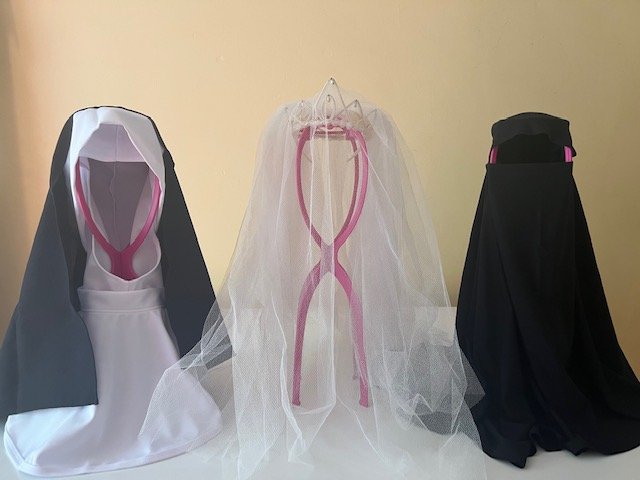Attributions and Artist Statement
Veils
One nun’s veil, bandeau, coif and guimpe in black and white
One bridal veil in white net with tiara and teardrop-shaped faux pearls
One niqab in black
All three on pink pedestals
39 1/2” x 34” x 17”
The pink pedestals are 8” x 20”
2024
This artwork has long been on my mind to make. It’s about the way females have been veiled in patriarchy, and that the veiling is historical, contemporary, and international. It’s a veiling that confuses faith, romance, and sexuality with the female form. It’s a veiling that demonstrates how patriarchy tries to control girls and women.
The clothing also represents uniformity, identification, simplification, and protection.
Spiritual and matrimonial allegiance can offer liberation from gendered expectations and dangers - nuns can avoid marriage and childbirth and attain a special status; females can feel legitimized by a public ceremony (the wedding) of male approval, and economically protected by being married in a culture that pays men more for equal work; and wearing a niqab signals religious commitment, and also wearing it means people can’t ogle one’s body. And yet. It’s the female body veiled. The implication is virginity, especially crucial to controlling female sexuality, and modesty, especially crucial to shame-based control. The double standard is typical in so many diverse cultures throughout history. I wish females were allowed the same freedoms as males, including when conjuring allegiance.
I put the clothing on pink pedestals because I didn’t want mannequins whose colors and facial features would narrow the interpretation of the art to a specific nationality or religion. Pink is a color that’s been gendered as female, and this assemblage is about the veiling of females.
Veiling suggests the pedestalization that claims to idealize and protect. The conundrum of being put on a pedestal is something my mom, Lucretia Baldwin “Teka” Ward, explained to me: to be put on a pedestal means you can be kicked off it.

